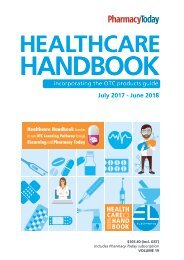2017 HCHB_digital
Create successful ePaper yourself
Turn your PDF publications into a flip-book with our unique Google optimized e-Paper software.
Urticaria (Hives)<br />
Urticaria refers to a group of skin disorders characterised by weals (also<br />
called hives) or angiodema, or both weals and angiodema forming on the<br />
skin. There are several different types of urticaria. Weals (also spelt wheal)<br />
may last from a few minutes to several hours and are pale or skin-coloured<br />
superficial swellings, usually surrounded by erythema (redness). Weals are<br />
generally itchy, 1–2cm in width, and may merge together to form a map-like<br />
pattern or one giant patch. The term urticaria is derived from the Latin word<br />
for stinging nettle, Urtica dioica.<br />
Occasionally, the surface weals may be accompanied by angioedema – which<br />
is a swelling beneath the skin that usually occurs around the facial area (ie, eyes<br />
and lips) but may also be present on the hands, feet, and throat. Angiodema may<br />
progress to anaphylaxis; symptoms include breathing and swallowing difficulty<br />
and shock (see Allergies). Urgent medical advice must be sought. Angioedema<br />
may also occur without weals.<br />
Urticaria can occur anywhere on the body but is mainly found on the trunk,<br />
arms and legs. Sometimes the rash can change shape and disappear from one<br />
place, only to reappear a few hours later somewhere else. The underlying chemical<br />
responsible for urticaria is histamine. Most cases of urticaria resolve within a few<br />
days although, occasionally, a person will have hives for many months or years.<br />
Acute urticaria<br />
Acute urticaria refers to a rash that lasts for less than six weeks. The rash may be<br />
triggered by an allergy or another non-allergic cause. Mast cells and white blood<br />
cells in the skin release histamine, which causes small blood vessels to leak fluid<br />
which pools to form weals.<br />
In acute urticaria due to an allergic cause, the substance responsible is usually<br />
ingested, inoculated, or inhaled, though in some people skin contact with the<br />
allergen may be enough to set off the urticaria (eg, latex). The most common<br />
allergic causes of urticaria are:<br />
• bee or wasp stings<br />
• foods – particularly nuts, fish or shellfish, eggs, tomatoes, eggs, berries, milk,<br />
strawberries and kiwifruit<br />
• latex<br />
• medicines – almost any type of medicine, either prescription or over the<br />
counter, although antibiotics are the most commonly implicated.<br />
Most cases of urticaria are NOT due to allergy, and can occur without previous<br />
exposure. Non-allergic causes of acute urticaria include:<br />
• contact with irritating plants (eg, thistles, stinging nettle) or stinging jellyfish<br />
• infections – such as viral upper respiratory tract infections (eg, colds, sinusitis),<br />
Candida infections, dental abscesses, Helicobacter pylori, viral hepatitis<br />
• non-allergic food reactions – common examples include salicylates in fruits,<br />
azo-dye food-colouring agents, benzoate preservatives, and histamine due to<br />
bacterial decomposition in fish (eg, scombroid fish poisoning)<br />
• non-allergic release of mast-cell granules, which can occur with opiates (eg,<br />
morphine, codeine) and radio-contrast agents<br />
• serum sickness – as a result of a blood transfusion, viral infection or medicines.<br />
TREATMENT OPTIONS<br />
Category Examples Comments<br />
Oral antihistamines<br />
Topical anti-itch products<br />
Natural / herbal products /<br />
supplements<br />
Non-sedating<br />
[PHARMACY ONLY MEDICINE]<br />
eg, cetirizine (Razene, Allerid-C, Histaclear,<br />
Zetop, Zyrtec tablets & liquid), desloratadine<br />
(Aerius Tablets), fexofenadine (Arrowcare<br />
Fexofast*, Hayfexo, Fexoclear, Telfast<br />
180*, Telfast Oral Liquid For Kids, Xergic),<br />
levocetirizine (Levrix), loratadine (Loraclear,<br />
Lorafix)<br />
Sedating<br />
[PHARMACIST ONLY MEDICINE]<br />
eg, dexchlorpheniramine (Polaramine),<br />
promethazine (Phenergan, Allersoothe)<br />
[PHARMACY ONLY MEDICINE]<br />
eg, Anthisan Cream<br />
Vitamin C<br />
Aloe vera gel<br />
These help to control total body itch and wheals. Try and eliminate the underlying cause (eg,<br />
food, medication).<br />
Oral antihistamines are more convenient than topical antihistamines when itch affects the<br />
whole body area.<br />
Generally non-sedating medicines do not cause drowsiness; however, some people may be<br />
more sensitive than others. Warn about the risks of driving or operating machinery if they do<br />
get drowsy.<br />
Similar to non-sedating antihistamines (above); however, these medicines can be quite<br />
sedating. May be useful when taken at night to improve sleep quality if itching is severe.<br />
Warn about the sedating effects and risks of driving or operating machinery while<br />
taking these medicines and to avoid alcohol (see Reference Section, OTC Medicine<br />
Precautions). Sedating antihistamines are [PRESCRIPTION ONLY MEDICINES] for children<br />
under two.<br />
Relieves localised itch and inflammation. Good for short-term use (two to three days) on<br />
small localised areas. Some people with sensitive skin may react to excipients in the cream<br />
and develop a contact dermatitis.<br />
Higher doses of vitamin C (ie, 1000mg) may help reduce histamine levels.<br />
Aloe vera has a cooling, soothing action.<br />
Products with an asterisk have a detailed listing in the Itchy Rash and Urticaria section of OTC Products, on page 266.<br />
PharmacyToday<br />
A part of your<br />
everyday<br />
Page 158 HEALTHCARE HANDBOOK <strong>2017</strong>-2018 Common Disorders



